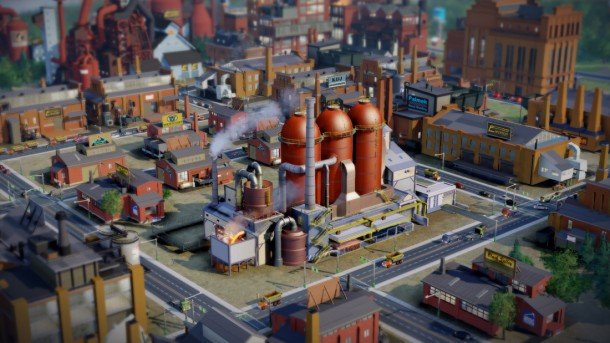SimCity interview: failure states, casinos, Minecraft, and the working class

Does gentrification exist in SimCity?
Librande: From a systems point of view, it definitely does. There are three parallel wealth tracks: low, medium, and high. When you look at how our scripting works, those three things run in parallel. They don't interact with each other too much. But as the player plays the game, you'll see low-wealth buildings become high- or mid-wealth buildings, and mid-wealth will become high-wealth. There are two stories you can tell, depending on what kind of person you are. One is that those rich people came in, they bought the poor people's land, kicked them out, and moved their mansions in on top. Then there's the other story, which is, oh, those low-wealth people made a lot of money, and so they did a home remodeling project and built up a bigger house for themselves. Both are kind of equally true, because the game doesn't tell you that this is what's happening. It's up to the player to make up that story and connect the dots in a way that they want to believe as a mayor, that this is what's happening.
Is it fair to say that all cities will need low-wealth workers to operate certain services?
Librande: Yeah. In some ways, they all need mid and high too. The proportions are skewed really heavily towards low wealth. You only need a couple of mansions. Those guys will be able to find jobs. But if you have too many mansions, the rich people won't find work. They'll leave the city because they can't find a job. Buildings won't turn on unless there's a certain number of workers in them, and that usually means you have to have some low-wealth workers. That said, they don't have to come from your own city. They can come from anywhere in the region. It's totally possible, and sometimes desirable, to build up a community of rich people that supplies wealthy workers to the whole region. Or you can build a gigantic slum and say, "I'm gonna supply all the low-wealth workers for the region.” You don't have to worry about building those guys in your cities.
Say I wanted to build a successful working-class city, but I didn't want it to become so successful that those workers started building mansions. Is that something I could do?
Librande: The player has direct control over both densities and the wealth level of buildings in the game. If you don't want any buildings to get taller, you can just make really small little two-lane streets. That forces buildings to stay low. You need wide avenues to support really tall skyscrapers. So you can control density that way. Wealth is controlled mostly through parks, but also... If you put down fire stations, schools, police, that will tend to make a place more attractive to higher-wealth people. If you put down garbage dumps and a lot of factories, sewage treatment plants, that will make it so wealthy people won't want to move there at all. You have a lot of control, both directly and indirectly, over whether you're going to get skyscrapers or small buildings, and over whether you're going to get poor people or rich people.
What system in SimCity do you consider the most technically sophisticated?
The biggest gaming news, reviews and hardware deals
Keep up to date with the most important stories and the best deals, as picked by the PC Gamer team.
Librande: Probably one of the richer systems is the casino system. You're basically converting tourism into money for your city. There's this mini-game there of, "Well, how do I get the tourists in? I'm gonna need buses, maybe an airport, some cruise ships." Each of those transportation systems caters to different wealth classes. Airports bring in rich people. Buses bring in poor people. But there are several different casinos, and once you're in a casino, depending on what kind of hotel and lodging you put on it and what kind of gaming modules you stick on it, you actually start tuning it for different wealth classes. There's this whole game of, "Which tourists can I get in easily? How much money do I make once they get into the casino? Is it better to have a few really rich people or to have thousands of poor people? What gives me more money?"
Honestly, I don't even know myself what's the best strategy, because there's so many different mix-and-match ways to use that system as a player. I would say, as a designer, we just gave you all these parts and said, "Here's the tool kit. Put it together and build your own game out of these parts. Play the game you want to try to play." It's definitely more difficult to bring in the rich people, because you have to support them with a lot of infrastructure like the airport. But they pay off so much that you don't need very many of them. You just need a couple of them and you're fine.
We're both in the Bay Area around San Francisco, so you know that we've been experiencing hilariously, unnecessarily bad traffic recently due to rain. Say you're floating over the sky as a SimCity mayor-god. You have the SimCity UI over the Bay Area. How would you fix San Francisco traffic using SimCity powers?
Librande: Wow. Hmm. Well, San Francisco is pretty messed up. They already have the light rail going on. They already have BART. They already have a lot of buses. Those are our main things you can play with in the game right now to try and ease that. You can make the roads wider. San Francisco specifically is so built up already, what are you going to do there? But that's what you would end up doing. At some point, as your buildings get taller and they hold more people, the more the people are driving, it chokes your city in a really bad way. You're forced, if you want to have a really big city... You're going to have to have some light rail or bus systems in place. The bay area has ferries, too, going across the bay. We have ferries in the game. But it seems like, in some ways, the bay area has already done what it can do. It's caught up with what we can do in our game.
How do you make room for players to enjoy watching SimCity as they play it? I'm occasionally going want to watch individual cars, individual Sims, and build narratives by watching these characters navigate the world. How do you approach designing a game that allows for that?
Librande: It's a good question. Some players don't care at all. This is around the office. You see them play. They're very min-max players. They want to prove they can make a certain amount of money per hour. Things like that. They tend to keep their camera back a little further. They treat all the Sims like they're just ants. They're a resource that they're using to power up their dreams. Then there's another type of player, myself included, who tend to make these really small, low-density cities. I like to watch people go to work. I keep the game on a slower speed. You can tell the min-maxers because they're usually running at cheetah speed. I think the game supports both play styles, both personalities, really well. It's really easy to go from one mode to the next. You can pause the game whenever you want. You can slow it down or speed it up.
It just depends on what mindset you're in at that moment. It is kind of mesmerizing, even for the min-maxers. Sometimes you'll just see them staring at a traffic intersection for a while, not doing anything. The patterns that all the cars and people make, they're just fascinating to watch. We let you pull the camera down fairly close, so you can see what's going on. Again, it depends on who you are and what you want to get out of the game. We try to support both styles.

Evan's a hardcore FPS enthusiast who joined PC Gamer in 2008. After an era spent publishing reviews, news, and cover features, he now oversees editorial operations for PC Gamer worldwide, including setting policy, training, and editing stories written by the wider team. His most-played FPSes are CS:GO, Team Fortress 2, Team Fortress Classic, Rainbow Six Siege, and Arma 2. His first multiplayer FPS was Quake 2, played on serial LAN in his uncle's basement, the ideal conditions for instilling a lifelong fondness for fragging. Evan also leads production of the PC Gaming Show, the annual E3 showcase event dedicated to PC gaming.

